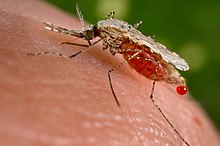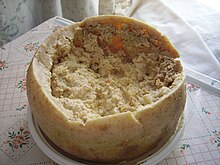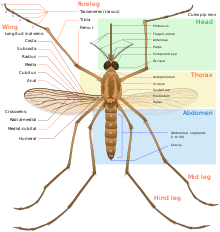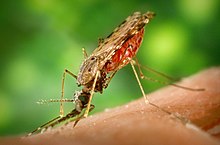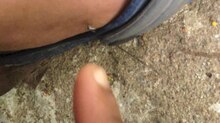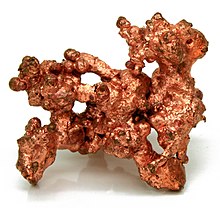| Fly | |
|---|---|

| |
| Syrphus ribesii, showing characteristic dipteran features: large eyes, small antennae, sucking mouthparts, single pair of flying wings, hindwings reduced to clublike halteres | |
| Scientific classification | |
| Kingdom: | Animalia |
| Phylum: | Arthropoda |
| Class: | Insecta |
| Superorder: | Panorpida |
| (unranked): | Antliophora |
| Order: | Diptera Linnaeus, 1758 |
True flies are insects of the order Diptera, the name being derived from the Greek δι- di- "two", and πτερόν pteron "wings". Insects of this order use only a single pair of wings to fly, the hindwings having evolved into advanced mechanosensory organs known as halteres, which act as high-speed sensors of rotational movement and allow dipterans to perform advanced aerobatics. Diptera is a large order containing an estimated 1,000,000 species including horse-flies, crane flies, hoverflies and others, although only about 125,000 species have been described.
Flies have a mobile head, with a pair of large compound eyes, and mouthparts designed for piercing and sucking (mosquitoes, black flies and robber flies), or for lapping and sucking in the other groups. Their wing arrangement gives them great maneuverability in flight, and claws and pads on their feet enable them to cling to smooth surfaces. Flies undergo complete metamorphosis; the eggs are laid on the larval food-source and the larvae, which lack true limbs, develop in a protected environment, often inside their food source. The pupa is a tough capsule from which the adult emerges when ready to do so; flies mostly have short lives as adults.
Diptera is one of the major insect orders and of considerable ecological and human importance. Flies are important pollinators, second only to the bees and their Hymenopteran relatives. Flies may have been among the evolutionarily earliest pollinators responsible for early plant pollination. Fruit flies are used as model organisms in research, but less benignly, mosquitoes are vectors for malaria, dengue, West Nile fever, yellow fever, encephalitis, and other infectious diseases; and houseflies, commensal with humans all over the world, spread food-borne illnesses. Flies can be annoyances especially in some parts of the world where they can occur in large numbers, buzzing and settling on the skin or eyes to bite or seek fluids. Larger flies such as tsetse flies and screwworms cause significant economic harm to cattle. Blowfly larvae, known as gentles, and other dipteran larvae, known more generally as maggots, are used as fishing bait and as food for carnivorous animals. They are also used in medicine in debridement to clean wounds.
Taxonomy and phylogeny
Relationships to other insects
Dipterans are endopterygotes, insects that undergo radical metamorphosis. They belong to the Mecopterida, alongside the Mecoptera, Siphonaptera, Lepidoptera and Trichoptera.
The possession of a single pair of wings distinguishes most true flies
from other insects with "fly" in their names. However, some true flies
such as Hippoboscidae (louse flies) have become secondarily wingless.
Fossil nematoceran in Dominican amber. Sandfly, Lutzomyia adiketis (Psychodidae), Early Miocene, c. 20 million years ago
Relationships between fly subgroups and families
The first true dipterans known are from the Middle Triassic (around 240 million years ago), and they became widespread during the Middle and Late Triassic. Modern flowering plants did not appear until the Cretaceous (around 140 million years ago), so the original dipterans must have had a different source of nutrition other than nectar. Based on the attraction of many modern fly groups to shiny droplets, it has been suggested that they may have fed on honeydew produced by sap-sucking bugs which were abundant at the time, and dipteran mouthparts are well-adapted to softening and lapping up the crusted residues. The basal clades in the Diptera include the Deuterophlebiidae and the enigmatic Nymphomyiidae. Three episodes of evolutionary radiation are thought to have occurred based on the fossil record. Many new species of lower Diptera developed in the Triassic, about 220 million years ago. Many lower Brachycera appeared in the Jurassic, some 180 million years ago. A third radiation took place among the Schizophora at the start of the Paleogene, 66 million years ago.
The phylogenetic position of Diptera has been controversial. The monophyly of holometabolous
insects has long been accepted, with the main orders being established
as Lepidoptera, Coleoptera, Hymenoptera and Diptera, and it is the
relationships between these groups which has caused difficulties.
Diptera is widely thought to be a member of Mecopterida,
along with Lepidoptera (butterflies and moths), Trichoptera
(caddisflies), Siphonaptera (fleas), Mecoptera (scorpionflies) and
possibly Strepsiptera
(twisted-wing flies). Diptera has been grouped with Siphonaptera and
Mecoptera in the Antliophora, but this has not been confirmed by
molecular studies.
Diptera were traditionally broken down into two suborders, Nematocera and Brachycera,
distinguished by the differences in antennae. The Nematocera are
identified by their elongated bodies and many-segmented, often feathery
antennae as represented by mosquitoes and crane flies. The Brachycera
have rounder bodies and much shorter antennae.
Subsequent studies have identified the Nematocera as being
non-monophyletic with modern phylogenies placing the Brachycera within
grades of groups formerly placed in the Nematocera. The construction of a
phylogenetic tree has been the subject of ongoing research. The
following cladogram is based on the FLYTREE project.
Diversity
Gauromydas heros is the largest fly in the world.
Flies are often abundant and are found in almost all terrestrial
habitats in the world apart from Antarctica. They include many familiar
insects such as house flies, blow flies, mosquitoes, gnats, black flies,
midges and fruit flies. More than 150,000 have been formally described and the actual species diversity is much greater, with the flies from many parts of the world yet to be studied intensively.
The suborder Nematocera include generally small, slender insects with
long antennae such as mosquitoes, gnats, midges and crane-flies, while
the Brachycera includes broader, more robust flies with short antennae.
Many nematoceran larvae are aquatic.
There are estimated to be a total of about 19,000 species of Diptera in
Europe, 22,000 in the Nearctic region, 20,000 in the Afrotropical
region, 23,000 in the Oriental region and 19,000 in the Australasian
region. While most species have restricted distributions, a few like the housefly (Musca domestica) are cosmopolitan. Gauromydas heros (Asiloidea), with a length of up to 7 cm (2.8 in), is generally considered to be the largest fly in the world, while the smallest is Euryplatea nanaknihali, which at 0.4 mm (0.016 in) is smaller than a grain of salt.
Brachycera are ecologically very diverse, with many being
predatory at the larval stage and some being parasitic. Animals
parasitised include molluscs, woodlice, millipedes, insects, mammals, and amphibians.
Flies are the second largest group of pollinators after the Hymenoptera
(bees, wasps and relatives). In wet and colder environments flies are
significantly more important as pollinators. Compared to bees, they need
less food as they do not need to provision their young. Many flowers
that bear low nectar and those that have evolved trap pollination depend on flies. It is thought that some of the earliest pollinators of plants may have been flies.
The greatest diversity of gall forming insects are found among the flies, principally in the family Cecidomyiidae (gall midges).
Many flies (most importantly in the family Agromyzidae) lay their eggs
in the mesophyll tissue of leaves with larvae feeding between the
surfaces forming blisters and mines.
Some families are mycophagous or fungus feeding. These include the cave
dwelling Mycetophilidae (fungus gnats) whose larvae are the only
diptera with bioluminescence. The Sciaridae are also fungus feeders.
Some plants are pollinated by fungus feeding flies that visit fungus
infected male flowers.
The larvae of Megaselia scalaris (Phoridae) are almost omnivorous and consume such substances as paint and shoe polish. The Exorista mella (Walker) fly are considered generalists and parasitoids of a variety of hosts. The larvae of the shore flies (Ephydridae) and some Chironomidae survive in extreme environments including glaciers (Diamesa sp., Chironomidae), hot springs, geysers, saline pools, sulphur pools, septic tanks and even crude oil (Helaeomyia petrolei). Adult hoverflies (Syrphidae) are well known for their mimicry and the larvae adopt diverse lifestyles including being inquiline scavengers inside the nests of social insects. Some brachycerans are agricultural pests, some bite animals and humans and suck their blood, and some transmit diseases.
Anatomy and morphology
Flies are adapted for aerial movement and typically have short and streamlined bodies. The first tagma of the fly, the head, bears the eyes, the antennae, and the mouthparts (the labrum, labium, mandible, and maxilla make up the mouthparts). The second tagma, the thorax,
bears the wings and contains the flight muscles on the second segment,
which is greatly enlarged; the first and third segments have been
reduced to collar-like structures, and the third segment bears the halteres, which help to balance the insect during flight. The third tagma is the abdomen consisting of 11 segments, some of which may be fused, and with the 3 hindmost segments modified for reproduction. Some Dipterans are mimics and can only be distinguished from their models by very careful inspection. An example of this is Spilomyia longicornis, which is a fly but mimics a vespid wasp.
Flies have a mobile head with a pair of large compound eyes on the sides of the head, and in most species, three small ocelli
on the top. The compound eyes may be close together or widely
separated, and in some instances are divided into a dorsal region and a
ventral region, perhaps to assist in swarming behaviour. The antennae
are well-developed but variable, being thread-like, feathery or
comb-like in the different families. The mouthparts are adapted for
piercing and sucking, as in the black flies, mosquitoes and robber
flies, and for lapping and sucking as in many other groups. Female horse-flies
use knife-like mandibles and maxillae to make a cross-shaped incision
in the host's skin and then lap up the blood that flows. The gut
includes large diverticulae, allowing the insect to store small quantities of liquid after a meal.
For visual course control, flies' optic flow field is analyzed by a set of motion-sensitive neurons.
A subset of these neurons is thought to be involved in using the optic
flow to estimate the parameters of self-motion, such as yaw, roll, and
sideward translation.
Other neurons are thought to be involved in analyzing the content of
the visual scene itself, such as separating figures from the ground
using motion parallax. The H1 neuron
is responsible for detecting horizontal motion across the entire visual
field of the fly, allowing the fly to generate and guide stabilizing
motor corrections midflight with respect to yaw.
The ocelli are concerned in the detection of changes in light
intensity, enabling the fly to react swiftly to the approach of an
object.
Like other insects, flies have chemoreceptors that detect smell and taste, and mechanoreceptors
that respond to touch. The third segments of the antennae and the
maxillary palps bear the main olfactory receptors, while the gustatory
receptors are in the labium, pharynx, feet, wing margins and female
genitalia,
enabling flies to taste their food by walking on it. The taste
receptors in females at the tip of the abdomen receive information on
the suitability of a site for ovipositing. Flies that feed on blood have special sensory structures that can detect infrared emissions, and use them to home in on their hosts, and many blood-sucking flies can detect the raised concentration of carbon dioxide that occurs near large animals. Some tachinid flies (Ormiinae) which are parasitoids of bush crickets, have sound receptors to help them locate their singing hosts.
Diptera have one pair of fore wings on the mesothorax and a pair of halteres, or reduced hind wings, on the metathorax. A further adaptation for flight is the reduction in number of the neural ganglia, and concentration of nerve tissue in the thorax, a feature that is most extreme in the highly derived Muscomorpha infraorder.
Some species of flies are exceptional in that they are secondarily
flightless. The only other order of insects bearing a single pair of
true, functional wings, in addition to any form of halteres, are the Strepsiptera. In contrast to the flies, the Strepsiptera bear their halteres on the mesothorax and their flight wings on the metathorax. Each of the fly's six legs
has a typical insect structure of coxa, trochanter, femur, tibia and
tarsus, with the tarsus in most instances being subdivided into five tarsomeres. At the tip of the limb is a pair of claws, and between these are cushion-like structures known as pulvilli which provide adhesion.
The abdomen shows considerable variability among members of the
order. It consists of eleven segments in primitive groups and ten
segments in more derived groups, the tenth and eleventh segments having
fused. The last two or three segments are adapted for reproduction. Each segment is made up of a dorsal and a ventral sclerite, connected by an elastic membrane. In some females, the sclerites are rolled into a flexible, telescopic ovipositor.
Flight
Flies are capable of great manoeuvrability during flight due to the presence of the halteres. These act as gyroscopic
organs and are rapidly oscillated in time with the wings; they act as a
balance and guidance system by providing rapid feedback to the
wing-steering muscles, and flies deprived of their halteres are unable
to fly. The wings and halteres move in synchrony but the amplitude of
each wing beat is independent, allowing the fly to turn sideways. The wings of the fly are attached to two kinds of muscles, those used to power it and another set used for fine control.
Flies tend to fly in a straight line then make a rapid change in
direction before continuing on a different straight path. The
directional changes are called saccades
and typically involve an angle of 90°, being achieved in 50
milliseconds. They are initiated by visual stimuli as the fly observes
an object, nerves then activate steering muscles in the thorax that
cause a small change in wing stroke which generate sufficient torque to
turn. Detecting this within four or five wingbeats, the halteres trigger
a counter-turn and the fly heads off in a new direction.
Flies have rapid reflexes that aid their escape from predators
but their sustained flight speeds are low. Dolichopodid flies in the
genus Condylostylus respond in less than 5 milliseconds to camera flashes by taking flight. In the past, the deer bot fly, Cephenemyia, was claimed to be one of the fastest insects on the basis of an estimate made visually by Charles Townsend in 1927.
This claim, of speeds of 600 to 800 miles per hour, was regularly
repeated until it was shown to be physically impossible as well as
incorrect by Irving Langmuir. Langmuir suggested an estimated speed of
25 miles per hour.
Although most flies live and fly close to the ground, a few are known to fly at heights and a few like Oscinella (Chloropidae) are known to be dispersed by winds at altitudes of up to 2000 ft and over long distances. Some hover flies like Metasyrphus corollae have been known to undertake long flights in response to aphid population spurts.
Males of fly species such as Cuterebra, many hover flies, bee flies (Bombyliidae) and fruit flies (Tephritidae) maintain territories within which they engage in aerial pursuit to drive away intruding males and other species. While these territories may be held by individual males, some species, such as A. freeborni, form leks with many males aggregating in displays.
Some flies maintain an airspace and still others form dense swarms that
maintain a stationary location with respect to landmarks. Many flies
mate in flight while swarming.
Life cycle and development
Mating anthomyiid flies
Diptera go through a complete metamorphosis with four distinct life stages – egg, larva, pupa and adult.
Larva
In many
flies, the larval stage is long and adults may have a short life. Most
dipteran larvae develop in protected environments; many are aquatic and
others are found in moist places such as carrion, fruit, vegetable
matter, fungi and, in the case of parasitic species, inside their hosts.
They tend to have thin cuticles and become desiccated if exposed to the
air. Apart from the Brachycera,
most dipteran larvae have sclerotinised head capsules, which may be
reduced to remnant mouth hooks; the Brachycera, however, have soft,
gelatinized head capsules from which the sclerites are reduced or
missing. Many of these larvae retract their heads into their thorax.
Some other anatomical distinction exists between the larvae of the Nematocera and the Brachycera.
Especially in the Brachycera, little demarcation is seen between the
thorax and abdomen, though the demarcation may be visible in many
Nematocera, such as mosquitoes; in the Brachycera, the head of the larva
is not clearly distinguishable from the rest of the body, and few, if
any, sclerites are present. Informally, such brachyceran larvae are
called maggots,
but the term is not technical and often applied indifferently to fly
larvae or insect larvae in general. The eyes and antennae of brachyceran
larvae are reduced or absent, and the abdomen also lacks appendages
such as cerci. This lack of features is an adaptation to food such as carrion, decaying detritus, or host tissues surrounding endoparasites. Nematoceran larvae generally have well-developed eyes and antennae, while those of Brachyceran larvae are reduced or modified.
Dipteran larvae have no jointed, "true legs", but some dipteran larvae, such as species of Simuliidae, Tabanidae and Vermileonidae, have prolegs adapted to hold onto a substrate in flowing water, host tissues or prey. The majority of dipterans are oviparous and lay batches of eggs, but some species are ovoviviparous,
where the larvae starting development inside the eggs before they hatch
or viviparous, the larvae hatching and maturing in the body of the
mother before being externally deposited. These are found especially in
groups that have larvae dependent on food sources that are short-lived
or are accessible for brief periods. This is widespread in some families such as the Sarcophagidae. In Hylemya strigosa (Anthomyiidae) the larva moults to the second instar before hatching, and in Termitoxenia
(Phoridae) females have incubation pouches, and a full developed third
instar larva is deposited by the adult and it almost immediately pupates
with no freely feeding larval stage. The tsetse fly (as well as other Glossinidae, Hippoboscidae, Nycteribidae and Streblidae) exhibits adenotrophic viviparity;
a single fertilised egg is retained in the oviduct and the developing
larva feeds on glandular secretions. When fully grown, the female finds a
spot with soft soil and the larva works its way out of the oviduct,
buries itself and pupates. Some flies like Lundstroemia parthenogenetica (Chironomidae) reproduce by thelytokous parthenogenesis, and some gall midges have larvae that can produce eggs (paedogenesis).
Pupa
The pupae
take various forms. In some groups, particularly the Nematocera, the
pupa is intermediate between the larval and adult form; these pupae are
described as "obtect", having the future appendages visible as
structures that adhere to the pupal body. The outer surface of the pupa
may be leathery and bear spines, respiratory features or locomotory
paddles. In other groups, described as "coarctate", the appendages are
not visible. In these, the outer surface is a puparium,
formed from the last larval skin, and the actual pupa is concealed
within. When the adult insect is ready to emerge from this tough,
desiccation-resistant capsule, it inflates a balloon-like structure on
its head, and forces its way out.
Adult
The adult
stage is usually short, its function only to mate and lay eggs. The
genitalia of male flies are rotated to a varying degree from the
position found in other insects.
In some flies, this is a temporary rotation during mating, but in
others, it is a permanent torsion of the organs that occurs during the
pupal stage. This torsion may lead to the anus
being below the genitals, or, in the case of 360° torsion, to the sperm
duct being wrapped around the gut and the external organs being in
their usual position. When flies mate, the male initially flies on top
of the female, facing in the same direction, but then turns around to
face in the opposite direction. This forces the male to lie on his back
for his genitalia to remain engaged with those of the female, or the
torsion of the male genitals allows the male to mate while remaining
upright. This leads to flies having more reproduction abilities than
most insects, and much quicker. Flies occur in large populations due to
their ability to mate effectively and quickly during the mating season.
Ecology
As ubiquitous insects, dipterans play an important role at various trophic levels
both as consumers and as prey. In some groups the larvae complete their
development without feeding, and in others the adults do not feed. The
larvae can be herbivores, scavengers, decomposers, predators or
parasites, with the consumption of decaying organic matter being one of
the most prevalent feeding behaviours. The fruit or detritus is consumed
along with the associated micro-organisms, a sieve-like filter in the
pharynx being used to concentrate the particles, while flesh-eating
larvae have mouth-hooks to help shred their food. The larvae of some
groups feed on or in the living tissues of plants and fungi, and some of
these are serious pests of agricultural crops. Some aquatic larvae
consume the films of algae that form underwater on rocks and plants.
Many of the parasitoid larvae grow inside and eventually kill other
arthropods, while parasitic larvae may attack vertebrate hosts.
Whereas many dipteran larvae are aquatic or live in enclosed
terrestrial locations, the majority of adults live above ground and are
capable of flight. Predominantly they feed on nectar or plant or animal
exudates, such as honeydew, for which their lapping mouthparts are
adapted. The flies that feed on vertebrate blood have sharp stylets that
pierce the skin, the insects inserting anticoagulant saliva and
absorbing the blood that flows; in this process, certain diseases can be
transmitted. The bot flies (Oestridae) have evolved to parasitize
mammals. Many species complete their life cycle inside the bodies of
their hosts.
In many dipteran groups, swarming is a feature of adult life, with
clouds of insects gathering in certain locations; these insects are
mostly males, and the swarm may serve the purpose of making their
location more visible to females.
Anti-predator adaptations
The large bee-fly, Bombylius major, is a Batesian mimic of bees.
Flies are eaten by other animals at all stages of their development.
The eggs and larvae are parasitised by other insects and are eaten by
many creatures, some of which specialise in feeding on flies but most of
which consume them as part of a mixed diet. Birds, bats, frogs,
lizards, dragonflies and spiders are among the predators of flies. Many flies have evolved mimetic resemblances that aid their protection. Batesian mimicry is widespread with many hoverflies resembling bees and wasps, ants and some species of tephritid fruit fly resembling spiders. Some species of hoverfly are myrmecophilous,
their young live and grow within the nests of ants. They are protected
from the ants by imitating chemical odours given by ant colony members. Bombyliid bee flies such as Bombylius major
are short-bodied, round, furry, and distinctly bee-like as they visit
flowers for nectar, and are likely also Batesian mimics of bees.
In contrast, Drosophila subobscura, a species of fly in the genus Drosophila, lacks a category of hemocytes that are present in other studied species of Drosophila, leading to an inability to defend against parasitic attacks, a form of innate immunodeficiency.
In culture
Symbolism
Petrus Christus's 1446 painting Portrait of a Carthusian has a fly painted on a trompe l'oeil frame.
Flies play a variety of symbolic roles in different cultures. These
include both positive and negative roles in religion. In the traditional
Navajo religion, Big Fly is an important spirit being. In Christian demonology, Beelzebub is a demonic fly, the "Lord of the Flies", and a god of the Philistines.
Flies have appeared in literature since ancient Sumer. In a Sumerian poem, a fly helps the goddess Inanna when her husband Dumuzid is being chased by galla demons. In the Mesopotamian versions of the flood myth, the dead corpses floating on the waters are compared to flies. Later, the gods are said to swarm "like flies" around the hero Utnapishtim's offering. Flies appear on Old Babylonian seals as symbols of Nergal, the god of death. Fly-shaped lapis lazuli beads were often worn in ancient Mesopotamia, along with other kinds of fly-jewellery.
In Prometheus Bound, which is attributed to the Athenian tragic playwright Aeschylus, a gadfly sent by Zeus's wife Hera pursues and torments his mistress Io, who has been transformed into a cow and is watched constantly by the hundred eyes of the herdsman Argus:
"Io: Ah! Hah! Again the prick, the stab of gadfly-sting! O earth,
earth, hide, the hollow shape—Argus—that evil thing—the hundred-eyed." William Shakespeare, inspired by Aeschylus, has Tom o'Bedlam in King Lear,
"Whom the foul fiend hath led through fire and through flame, through
ford and whirlpool, o'er bog and quagmire", driven mad by the constant
pursuit. In Antony and Cleopatra, Shakespeare similarly likens Cleopatra's hasty departure from the Actium battlefield to that of a cow chased by a gadfly. More recently, in 1962 the biologist Vincent Dethier wrote To Know a Fly, introducing the general reader to the behaviour and physiology of the fly.
Flies appear in popular culture in concepts such as fly-on-the-wall documentary-making in film and television production. The metaphoric name suggests that events are seen candidly, as a fly might see them. Flies have inspired the design of miniature flying robots. Steven Spielberg's 1993 film Jurassic Park relied on the idea that DNA could be preserved in the stomach contents of a blood-sucking fly fossilised in amber, though the mechanism has been discounted by scientists.
Economic importance
An Anopheles stephensi mosquito drinking human blood. The species carries malaria.
Dipterans are an important group of insects and have a considerable impact on the environment. Some leaf-miner flies (Agromyzidae), fruit flies (Tephritidae and Drosophilidae) and gall midges (Cecidomyiidae) are pests of agricultural crops; others such as tsetse flies, screwworm and botflies (Oestridae) attack livestock, causing wounds, spreading disease, and creating significant economic harm. See article: Parasitic flies of domestic animals. A few can even cause myiasis in humans. Still others such as mosquitoes (Culicidae), blackflies (Simuliidae) and drain flies (Psychodidae) impact human health, acting as vectors of major tropical diseases.
Among these, Anopheles mosquitoes transmit malaria, filariasis, and arboviruses; Aedes aegypti mosquitoes carry dengue fever and the Zika virus; blackflies carry river blindness; sand flies carry leishmaniasis.
Other dipterans are a nuisance to humans, especially when present in
large numbers; these include houseflies, which contaminate food and
spread food-borne illnesses; the biting midges and sandflies (Ceratopogonidae) and the houseflies and stable flies (Muscidae). In tropical regions, eye flies (Chloropidae) which visit the eye in search of fluids can be a nuisance in some seasons.
Many dipterans serve roles that are useful to humans. Houseflies, blowflies and fungus gnats (Mycetophilidae) are scavengers and aid in decomposition. Robber flies (Asilidae), tachinids (Tachinidae) and dagger flies and balloon flies (Empididae) are predators and parasitoids of other insects, helping to control a variety of pests. Many dipterans such as bee flies (Bombyliidae) and hoverflies (Syrphidae) are pollinators of crop plants.
Uses
Diptera in research: Drosophila melanogaster fruit fly larvae being bred in tubes in a genetics laboratory
Drosophila melanogaster, a fruit fly, has long been used as a model organism in research because of the ease with which it can be bred and reared in the laboratory, its small genome, and the fact that many of its genes have counterparts in higher eukaryotes.
A large number of genetic studies have been undertaken based on this
species; these have had a profound impact on the study of gene expression, gene regulatory mechanisms and mutation. Other studies have investigated physiology, microbial pathogenesis and development among other research topics. The studies on dipteran relationships by Willi Hennig helped in the development of cladistics, techniques that he applied to morphological characters but now adapted for use with molecular sequences in phylogenetics.
Blowflies feeding on the fresh corpse of a porcupine, Hystrix africaeaustralis
Maggots found on corpses are useful to forensic entomologists. Maggot species can be identified by their anatomical features and by matching their DNA.
Maggots of different species of flies visit corpses and carcases at
fairly well-defined times after the death of the victim, and so do their
predators, such as beetles in the family Histeridae.
Thus, the presence or absence of particular species provides evidence
for the time since death, and sometimes other details such as the place
of death, when species are confined to particular habitats such as woodland.
Maggots used as animal feed at London Zoo
Some species of maggots such as blowfly larvae (gentles) and bluebottle larvae (casters) are bred commercially; they are sold as bait in angling, and as food for carnivorous animals (kept as pets, in zoos, or for research) such as some mammals, fishes, reptiles, and birds.
It has been suggested that fly larvae could be used at a large scale as
food for farmed chickens, pigs, and fish. However, consumers are
opposed to the inclusion of insects in their food, and the use of
insects in animal feed remains illegal in areas such as the European Union.
Casu marzu is a traditional Sardinian sheep milk cheese that contains larvae of the cheese fly, Piophila casei.
Fly larvae can be used as a biomedical tool for wound care and treatment. Maggot debridement therapy (MDT) is the use of blow fly
larvae to remove the dead tissue from wounds, most commonly being
amputations. Historically, this has been used for centuries, both
intentional and unintentional, on battlefields and in early hospital
settings. Removing the dead tissue promotes cell growth and healthy wound healing. The larvae also have biochemical properties such as antibacterial activity found in their secretions as they feed. These medicinal maggots are a safe and effective treatment for chronic wounds.
The Sardinian cheese casu marzu is exposed to flies known as cheese skippers such as Piophila casei, members of the family Piophilidae.
The digestive activities of the fly larvae soften the cheese and modify
the aroma as part of the process of maturation. At one time European
Union authorities banned sale of the cheese and it was becoming hard to
find, but the ban has been lifted on the grounds that the cheese is a traditional local product made by traditional methods.










